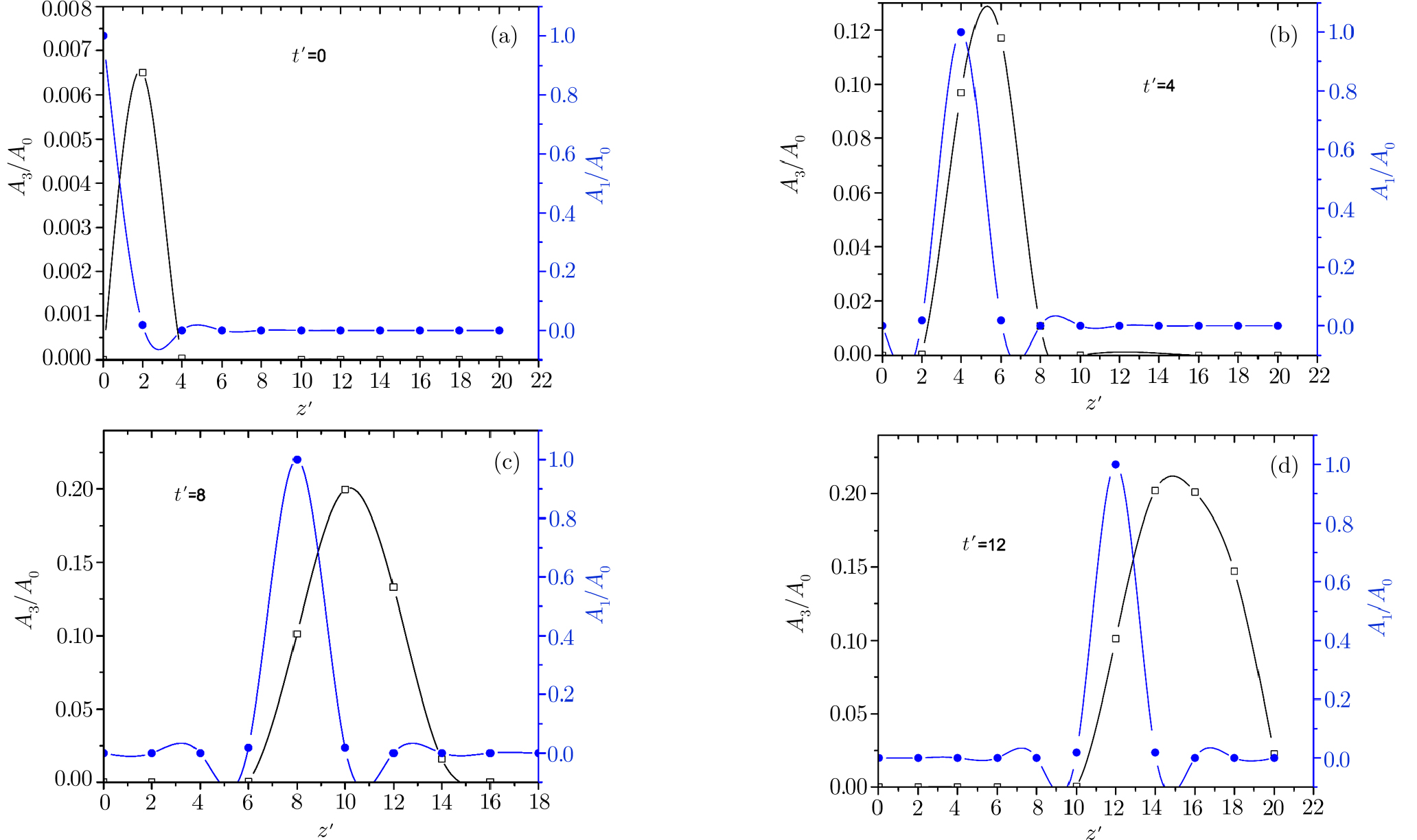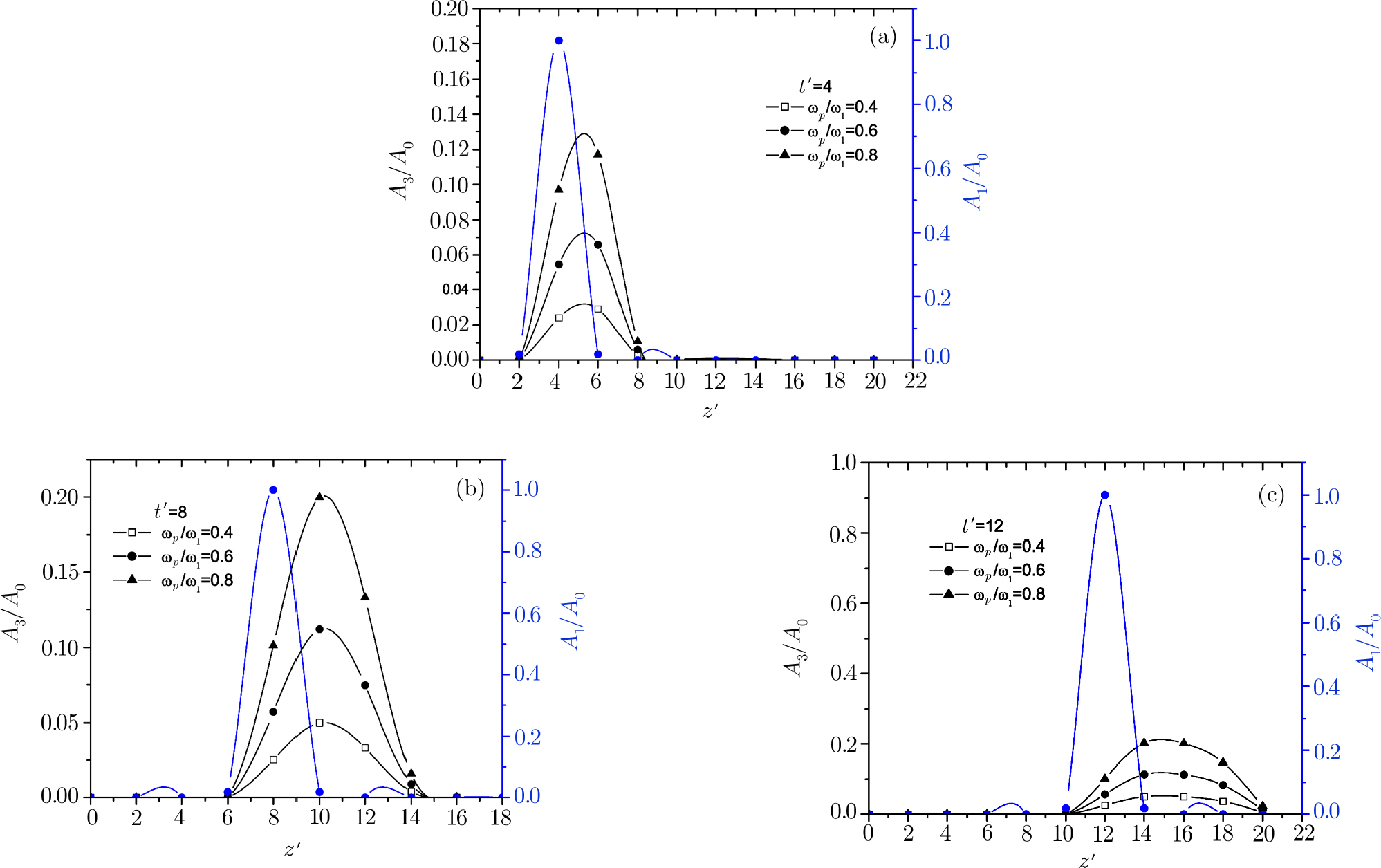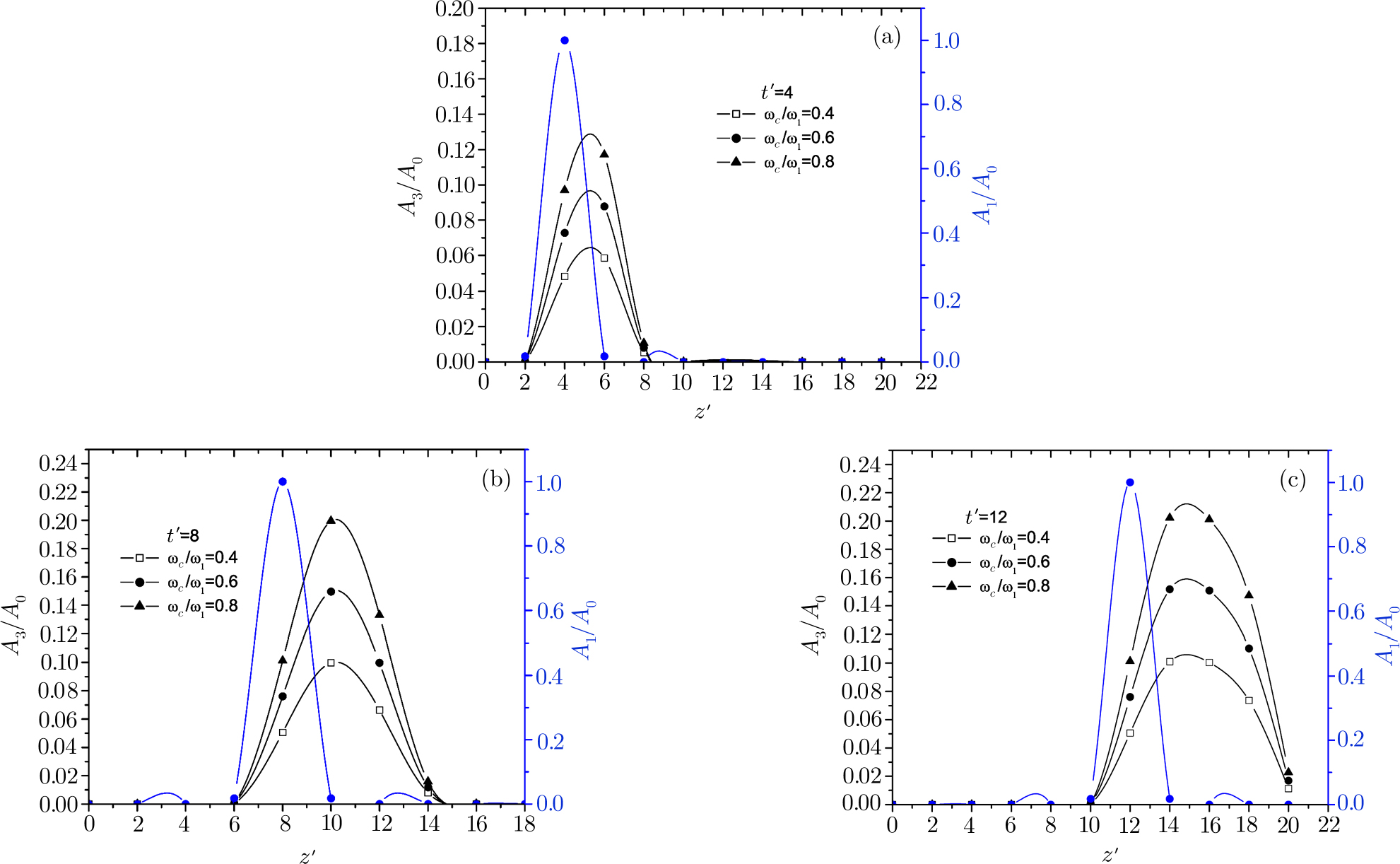† Corresponding author. E-mail:
Supported by a financial grant from CSIR, New Delhi, India, under Project No. 03(1438)/18/EMR-II
Effect of pulse slippage on resonant third harmonic generation of a short pulse laser in electron-hole plasma in the presence of wiggler magnetic field has been investigated. The group velocity mismatch of the third harmonic pulse and the fundamental pulse is significant in electron hole plasma. As the third harmonic pulse has higher group velocity than that of fundamental pulse, therefore, it moves faster than the fundamental pulse. It gets slipped out of the domain of fundamental pulse and its amplitude saturates. Phase matching condition is satisfied by applying wiggler magnetic field, which provides additional angular momentum to the third harmonic photon to make the process resonant. Enhancement in the efficiency of third harmonic generation of an intense short pulse laser in electron-hole plasma embedded with a magnetic wiggler is seen.
The interaction of short pulse laser with plasma and semiconductor has been of a great importance since the invention of high power laser and it plays a major role in the study of various non-linear phenomena.[1–5] One of which is harmonic generation, which is observed under different conditions.[6–7] Harmonic generation during laser plasma interaction is non-linear phenomenon as the electric field of incident laser pulse is comparable to the interatomic field of the medium, hence, nonlinearity arises. Harmonic generation in semiconductor plasma has been a fascinating field of research for last few decades. Third harmonic generation plays an important role in the coherent output of infrared lasers to shorter wavelengths in the visible and near ultraviolet, which makes intense laser filaments useful for remote sensing applications.[8] During the interaction of short pulse laser with semiconductor, the electron by absorbing photon of required energy get excited to the higher levels and leaving behind holes.
Singh et al.[9] studied the effect of magnetic field on the generation of third harmonic in plasma. When intense Gaussian laser beam is incident in the plasma, it exerts the ponderomotive force on electrons which results in self-focusing of the beam. Magnetic field affects the dynamics of the electrons which in turn modified the plasma waves. The ponderomotive force at second harmonic produced the electron density perturbation that beats with oscillatory velocity of electron to generate the current which drives the third harmonic generation. Kant et al.[10] studied the interaction of laser pulse with semiconductor plasma embedded with wiggler magnetic field which provides the phase matching for third harmonic generation in two different ways i.e., one by producing a transverse third harmonic current and the other by imparting sufficient momentum to third harmonic photons. Rajput et al.[11] gave description about the effect of external wiggler magnetic field on the pulse slippage in the third harmonic generation. As the third harmonic pulse has higher group velocity as compared to the fundamental pulse, so it moves forward and slips out from the domain of the fundamental pulse. The external magnetic field is required to satisfy the phase matching condition in order to enhance the efficiency of third harmonic. Rathore et al.[12] studied the phase matched third harmonic generation of laser pulses in the high density quantum plasma in the presence of wiggler magnetic field. They used the quantum hydrodynamic model and considered the quantum effect including the 1/2 spin effect. Thakur et al.[13] have seen the effect of density transition on the generation of third harmonic. They studied that the density transition improves the conversion efficiency of the generated harmonic in the presence of wiggler magnetic field.
Liu et al.[14] studied the harmonic generation due to femto second laser pulses from Ti-Sapphire in BBO crystal. They accounted that due to high non linearity of BBO crystal laser light up to ultra violet region can be produced. They calculated the results by considering the effect of group velocity mismatch along with group velocity dispersion of second harmonic. Aggarwal et al.[15] studied the harmonic generation of laser pulses in atomic cluster embedded with wiggler magnetic field. They studied the consequence of change in cluster size on the efficiency of second harmonic. Rax et al.[16] demonstrated that the interaction of laser pulses with plasma induces the non-linearity at the third harmonic. But due to nonlinear dispersion the pump and harmonic are unlocked and results in saturation. To make the phase matching conditions satisfy they have used the concept of resonant density modulation. Gibbon[17] studied the harmonic generation of femtosecond laser interaction with overdense plasma. They used the concept of particle-in-box to study the harmonic generation by reflection of intense light from overdense plasma. They also concluded that there is no cut of frequency corresponding to lower intensity laser reflected from the upper density. By this method they studied the generation of water window x-rays with higher efficiency.
Thakur et al.[18] studied the propagation of high power laser pulse, through a semiconductor under chirped pulse effect and observed the very interesting non-linear phenomenon of second harmonic generation. Further, it was noticed that when a high intense laser beam propagates through a semiconductor under the combined effect of wiggler magnetic field, the transverse current density starts oscillating with a frequency twice of the laser beam. In case of semiconductor, as free charge carriers are created in pairs consisting of an electron and a hole. Absorption process is contributed by the mobility of the holes which, behaves like electrons. The total absorption coefficient comprises of the lattice and the carrier absorption coefficients. Further on heating more carriers are produced, which in turn reinforces the absorption. This is how electron-hole plasma helps to generate third harmonic generation.
In the present work we consider the propagation of short pulse laser in the electron-hole plasma with dielectric constant εl = 14 in the presence of wiggler magnetic field and observe the effect of pulse slippage on the generation of third harmonic in electron-hole plasma. We solve the corresponding equations for the generation of third harmonic. It has been noticed that presence of the wiggler magnetic field plays a very crucial role in the enhancement of the efficiency of third harmonic generation.
In Sec.
Consider the propagation of a strong short pulse laser in plasma in the existence of a wiggler magnetic field 































To exert a ponderomotive force on electrons at 




















The non-linear current density at the third harmonic comes out to be 





For the third harmonic field 














Normalized amplitude of third harmonic comes out as,

In case of semiconductor, as free charge carriers are created in pairs consisting of an electron and a hole. Absorption process is contributed by the mobility of the holes which, behaves like electrons. The total absorption coefficient comprises of the lattice and the carrier absorption coefficients. Further, on heating, more carriers are produced which in turn reinforces the absorption. This is how electron-hole plasma helps to generate third harmonic generation. By considering the propagation of short pulse laser in the electron-hole plasma with dielectric constant εl = 14 in the presence of wiggler magnetic field, we have observed the effect of pulse slippage on the generation of third harmonic in electron-hole plasma. A combination of numerical parameters can be chosen depending upon experimental conveniences and requirements. For typical case, electron hole plasma (n-type Ge semiconductor) with a doping level n0 ≈ 1017 cm−3 is irradiated by a CO2 laser having angular frequency ω1 = 1.8 × 1014 rad/sec, with collisional frequency ν = 1012 s−1. Figure 
Figures
The mismatch of group velocities of the third harmonic pulse and the fundamental pulse is significant in the interaction of laser pulse with electron hole plasma. The group velocity of the third harmonic pulse is found to be greater than that of the fundamental pulse hence, the third harmonic pulse starts slipping out from the domain of fundamental pulse. Pulse slippage effect becomes more significant with the normalized distance of propagation. Third harmonic pulse slips out of the fundamental domain and gets saturated. This happens because of high intensity of fundamental pulse having Gaussian beam profile on the axis, it repels the electrons away from the axis, which causes to decrease in density which in turns decrease the plasma frequency hence, less energy is converted into third harmonic pulse. The presence of external magnetic field plays a very crucial role to enhance the efficiency of the third harmonic pulse. It is calculated that as the strength of the wiggler magnetic field is increased, the normalized amplitude of the third harmonic pulse also increases significantly.
| [1] | |
| [2] | |
| [3] | |
| [4] | |
| [5] | |
| [6] | |
| [7] | |
| [8] | |
| [9] | |
| [10] | |
| [11] | |
| [12] | |
| [13] | |
| [14] | |
| [15] | |
| [16] | |
| [17] | |
| [18] | |
| [19] | |
| [20] |





